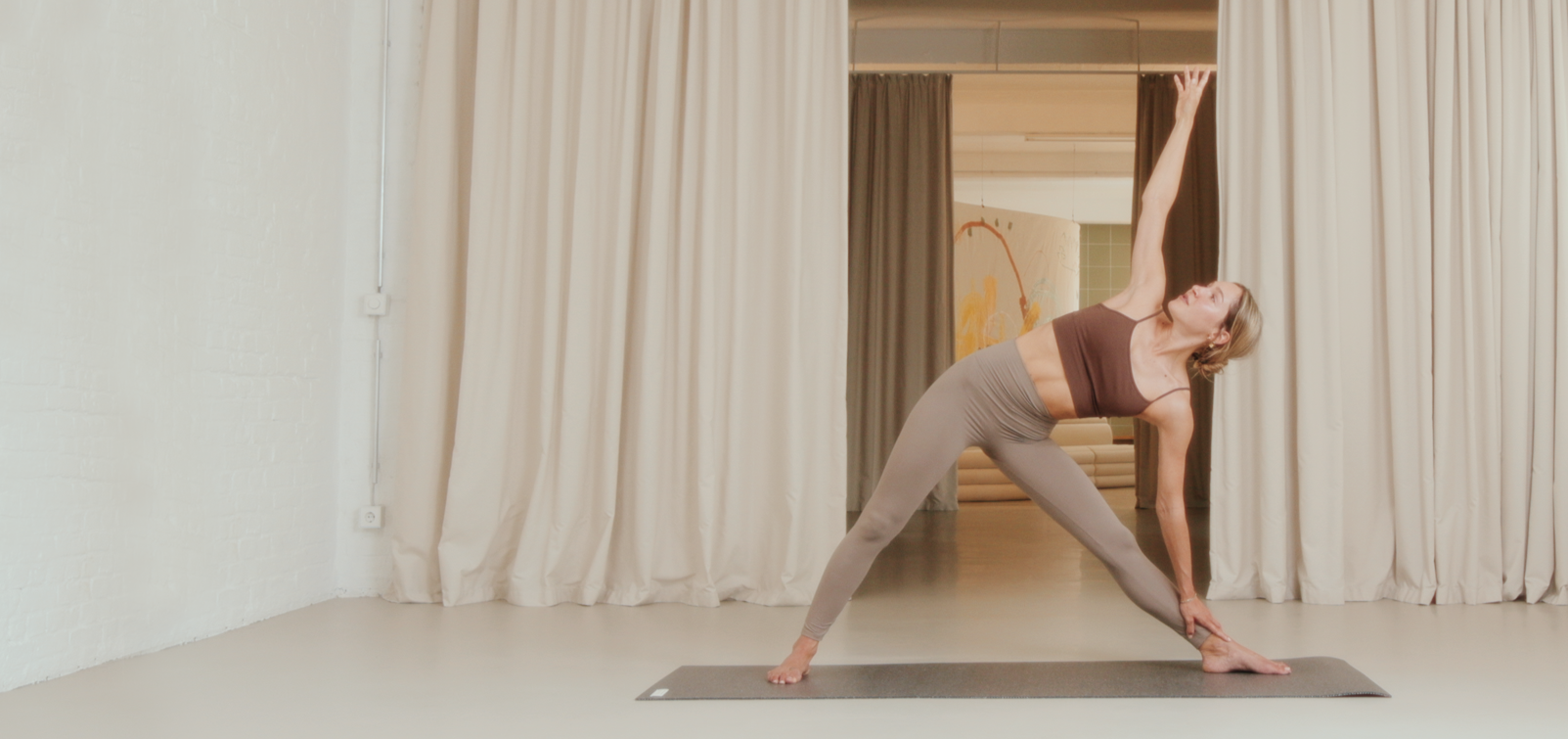Sabine Gallei is a yoga teacher, knitwear designer/stylist, mother of three young sons and founder of YES YOU ARE (@yes.you.are_). Sabine teaches open yoga classes, private classes, business yoga, pre- and postnatal yoga as well as workshops, retreats and teacher trainings in various studios in Berlin. All online too, of course. We are very pleased that Sabine has written a guest article for our blog. Thanks to her, we learned a lot about yoga during pregnancy and discovered 7 asanas that are especially good for yoga in pregnancy.
Yoga during pregnancy is a great companion in many ways and a holistic preparation for birth. It supports you to engage in change – physically, mentally and emotionally. Practising yoga means giving yourself and your baby attention and building a connection.
Specific, strengthening and opening asanas, calming pranayama and relaxing meditation deepen body awareness and feminine intuition. Yoga can relieve pregnancy discomfort through specific exercises. Relaxation, calmness, balance, as well as the quality of letting go and accepting, are the essential aspects of pregnant women’s yoga. Powerful sequences are always about specifically living through tension. Time on the mat helps you deal with stress and challenges in everyday life. All these aspects serve to fully tune inwardly and physically to the day of birth and to look forward to it with confidence, anticipation and serenity.


Pregnancy Yoga vs. normal yoga classes
It is important to know that Prenatal Yoga is different from normal yoga classes! Many of the asanas and breathing exercises from conventional yoga classes are not suitable for pregnancy and should be adapted. Because not every asana is suitable and advisable for every pregnant woman, in every trimester.
- Trimester
The first trimester (1st to 12th week) is not called the phase of adjustment without reason. Hormonal changes, emotionality, tiredness or sickness can characterise this first period. This should also be reflected in a more adapted, gentler practice. Feel free to lower your performance standards, consciously observe the changes and breathe deeply.
- Trimester
For many pregnant women, the second trimester is the phase of well-being, vitality and strength (13th to 24th week). Many moms-to-be now enjoy a vigorous yoga class with periods of relaxation. Balancing activity and rest are important at this time. The growing belly also requires further adjustments to individual asanas.
- Trimester
The third trimester is the phase of greatest physical and sometimes emotional challenge up to the preparation for birth (25th to 40th week). Due to the additional weight and the size of the belly, the freedom of movement is now even more restricted. Sometimes minor or major physical complaints (symphysis, water retention or similar) also occur during this time. Energetic movements should alternate in practice with supported, gentle stretches and longer periods of relaxation. The qualities of letting go, trust, surrender, calm and relaxation are the focus here. Breathing exercises and sounding belong in a well-rounded pregnancy class, as do meditation and relaxation exercises, in order to also prepare inwardly for the day of birth and to connect with the baby.
If you have never practised yoga before your pregnancy or only very irregularly, you should definitely attend prenatal classes during pregnancy. If you already had an advanced yoga practice before your pregnancy, you can probably continue a more vigorous practice – with modifications for pregnant women – after the first trimester. In principle, however, the following always applies: “Less is more!” Especially yoga during pregnancy at home in online yoga, it is even more important that you take good care of yourself and your baby.
DO’s in Prenatal Yoga
- The breath should always be able to flow calmly. Every inhalation brings new energy, every exhalation has a purifying effect. Thoughts and emotions can be influenced through the conscious breath, tensions are released and the mind can find peace. During pregnancy, the expectant mother breathes for two. The breathing volume increases by up to 40 per cent. The growing uterus increasingly restricts the movement of the diaphragm. Like to focus on the exhalation and try to connect your movements with the breath.
- Ensure precise alignment of the body: a solid base of the hands and feet, your pelvis should be neutral in relation to the spine, your upper body is erect, joint over joint.
- Every posture should give space for the belly. The abdomen should remain soft while practising.
- The feet are always hip-width open to keep space for the belly, especially in the forward bends.
- Use aids to make the practice more accessible and enjoyable (blocks, bolsters, belts, blankets, balls).
- Postures that challenge the abdominal muscles can be practised in a simplified way (lowering the knees in a push-up) or completely left out.
- Make sure to practice backbends only gently.
- Take time for the transitions from one posture to the next. Always come up from lying on your side and gently from sitting to standing.
- Support yourself with balance postures. Use the wall or a belt to help you.
- Practice pelvic floor awareness: practice letting go and activating, for example in the deep squat or in the supported shoulder bridge.
- Always make sure you don’t overstretch! During pregnancy, muscles, ligaments and connective tissue are softer anyway and you are particularly flexible and stretchy.
- Basically, everything that feels good and right is allowed. The first three months you should practice with caution and gently.
- If you feel discomfort, pain, dizziness or nausea during yoga practice, change position immediately or take a break.
- In case of recurring pain during or after the practice, consult the midwife or doctor.
- Always conclude the practice with at least a short savasana in the side position with a cushion between the legs or a seated meditation.
DONT’s in Prenatal Yoga
- Tight rotations and twisting postures (only to the open side!)
- Exercises to strengthen the abdominal muscles (especially no exercises for the straight abdominal muscles)
- Prone position
- Extreme backbends (e.g. full wheel)
- Staying in the supine position for a long time: The supine position can cause circulatory problems, dizziness and nausea, especially in the last weeks of pregnancy (vena cava compression syndrome).
- Jumping
- Excessive stretching or stretching of the abdomen
- Asanas with a risk of falling or too demanding inversion postures
- Intense Pranayama/Breath Holding
Daily Yoga Essentials – Pregnancy and Yoga
The Daily Yoga Essentials are single yoga exercises that can usually be practised without hesitation until the day of birth. It doesn’t always have to be a 90-minute class. 10 to 20 minutes every day in addition to a balanced, longer yoga class with an experienced yoga teacher is the perfect yoga routine. These short sequences can be integrated into everyday life, energise, have a balancing effect and simply put you in a good mood. If you have any complaints or are unsure, please check your practice with your doctor beforehand. As always, if it doesn’t feel good, don’t do it.
For your daily yoga practice, create a comfortable atmosphere and make sure that your mat has enough space. Have your tools ready, such as yoga blocks, bolsters or (nursing) cushions. Maybe also something to drink. Always begin your practice with a short centring in the seat. Close your eyes for this.
The Sun Salutation for Pregnant Women (Variation 1)
The sun salutation is one of the basic movement sequences in yoga. It is ideal for warming up and connecting breath and movement. It serves to warm up the body and prepare it for the following asanas. At the same time, it is a very effective routine in itself, as all the important muscle groups are stretched and strengthened.
In prenatal yoga there are many variations of the sun salutation, the important thing is to replace the prone position, pay good attention to the body’s signals and adjust the pace accordingly. You can take your time, especially with the transitions, and always feel free to use aids (yoga blocks).

Cat Cow Flow
“Cat & Cow” mobilises the spine, releases tension and relieves back pain. If you have sensitive knees, put a blanket under your knees. Starting from the quadruped position (wrists under the shoulders, knees hip-width under the hips) round the back with the exhalation. Inhaling lift the sternum, gently open the heart. Your breath leads the movement.
Alternatively, pelvic circles in quadrupedal position.

Adho Mukha Svanasana
Downward Looking Dog (Adho Mukha Svanasana) can already be very challenging depending on previous experience and the week of pregnancy. With your exhalation from the quadruped, push your pelvis upwards and make sure that the feet are wide enough open. Gladly keep your knees bent and find the length in your spine. Remind yourself to keep bringing your baby a little closer so that you don’t fall into a hollow back. Breathe in and out evenly. To open up the backs of the legs, you can alternately ground the heels (treading water) or lift one leg at a time. Then pause briefly in the child’s position. Repeat 3-5 times.

Balasana – Child’s Position
Balasana is one of the most important positions during pregnancy: here your breath can calm down, you can relax and let go. Open your knees so that there is enough room for your belly. You can gently rest your forehead on a block, pillow or your fists. If you want to stay longer in this restorative position, support yourself with a yoga cushion or pillow under your chest and head so that your belly has enough space. For knee problems, clamp a folded or slightly rolled blanket between your calves and thighs.
Concentrate on your breathing, lengthen the exhalation, this calms the mind and has a balancing effect. In addition, forward leaning positions promote a positive fetal birth position.

Prasarita Padottanasana
“Prasarita” in Sanskrit means stretched out, “Pada” means foot, “Ut” intense, “Tan” stretching and “Asana” pose. Long name, great effect. The straddled standing forward bend is also an effective daily essential, especially in combination with a twist. Not only the many positive effects on the body (stretching the backs of the legs, opening the pelvic area, deepening the breath, mobilising the spine), Prasarita Padottanasana also calms and grounds. You practise the qualities of letting go and surrender.
Find a straddle that is appropriate for you (tighter if you have symphysis problems). Make sure the outer edges of your feet are parallel and well grounded. Place one hand in the centre of the block underneath you. Keep the pelvis parallel to the earth, bring your baby a little closer so that you avoid a hollow back. With the inhalation create length in the spine again, with the exhalation open the other hand upwards, now bring the two shoulders over each other. Your gaze may follow the upper hand. Hold for three to five breaths and then mindfully switch to the other side.

Baddha Konasana
The butterfly stretches the entire pelvic area, opens the hips, promotes blood circulation in the abdomen and pelvic area, prevents back pain and reduces stress. It is best to sit slightly elevated on a blanket so that your lower back can straighten more easily. Bring the insides of the feet together. You can vary the distance between the feet and the pubic bone. Grasp the backs of your feet with your hands. With the inhalation grow in length, with the exhalation hold this position and let go of the legs, hips, pelvic floor. Breathe evenly. You should not practise the butterfly if you have symphyseal discomfort, pelvic floor problems or preterm labour.

Malasana
The deep squat is one of the classic prenatal yoga postures and is also a birthing posture. For the deep squat, bend the knees and make sure the knees and feet are aligned. The feet should be flat on the floor, if this is not possible you can put a rolled blanket or mat under the heels. Another possible support here can be a yoga cushion/ nursing pillow on which you sit. The back should be as straight and erect as possible in the position, the shoulders relaxed, the abdomen soft. Let the breath flow freely and calmly. The deep squat relieves back pain during pregnancy, supports digestion, opens the pelvis, gently stretches the pelvic floor and perineal tissues. Hold the squat for one to three minutes, with the support of a bolster or against the wall it can be held longer.
The full deep squat should be avoided in the following contraindications: The breath cannot flow freely, the abdomen does not have enough room, pain (e.g. in the back, knees, hips or symphysis), the baby is in breech presentation in late pregnancy, weak pelvic floor or preterm labour.

Savasana final relaxation (at least 5 min.)
Savasana is one of the most important, beautiful and perhaps also most difficult exercises in yoga, at least for the mind! From the 24th week, the supine position is usually very uncomfortable, and it can also promote the so-called vena cava syndrome: the weight of the baby interrupts the blood supply to the vena cava. Dizziness and nausea may occur. The lateral position is a nice relaxation posture even in early pregnancy. It is important to use a pillow between the legs for support (especially with symphysis problems) so that the hips and pelvis can let go properly. Underpinning for the head or abdomen (later in pregnancy) can also be comfortable. Keep warm and lie down on your favourite side. Take a long exhale and a deep inhale. Keep your eyes gently closed. Take at least 5 minutes to rest and connect with yourself, your breath and your baby.

We hope you enjoy trying out these wonderful asanas. Thank you Sabine for your valuable words. If you want to get more into the topic, practice with YES YOU ARE online: https://www.youtube.com/@yesyouare1426
Or take a look at Eversports under YES YOU ARE by Sabine Gallei. Here you can find all classes and workshops. Currently, there is a Prenatal Yoga Flow (online live via Zoom) every Monday from 18.30h to 19.30h or Wednesdays from 9.15h to 9.45h. If you have any questions, please contact Sabine at info@yesyouare.com.
On our hejhej Youtube channel we have a Prenatal Yoga Flow for the 3rd trimester | 30 min (german) free for you.
Illustrations: Nina Sophie Gekeler (www.patternstudio.de)
Photos: Maria Schiffer (@mariaschifferphotography)
Prenatal photos: Lena Fingerle (@lenafingerle)
This post was first published in German in March 2021 by littleyears




